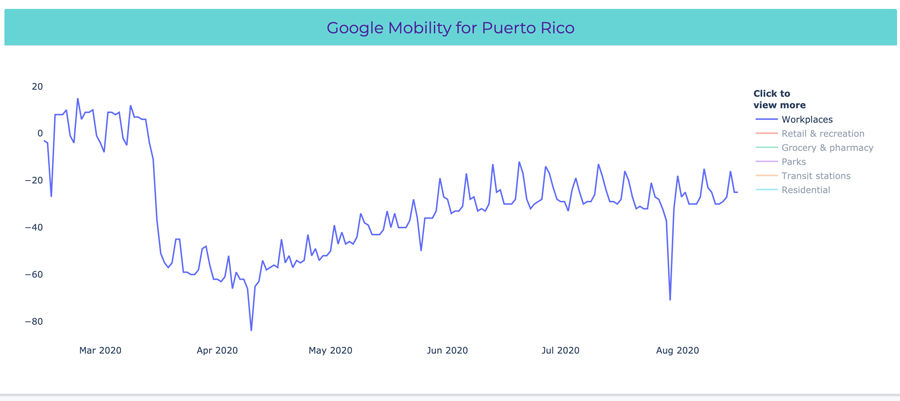Puerto Rico-based business intelligence firm Abexus Analytics has developed and made freely available the Abexus Mobility Insights tool, which tracks cellphone data using Google Mobility’s database and could help the government establish public policy related to the COVID-19 pandemic.
The tool follows how island residents move across all 78 towns and has already produced multiple trends that citizens and businesses should be aware of, company representatives said.
“Using our tool, you can clearly see the drop in transit and overall citizen movement during the Isaias storm,” said Adrián Alós, economist and lead programmer at Abexus Analytics, referring to the weather system that hit Puerto Rico earlier this month. “Moreover, we identified several municipalities that had surges in the dates of visits to supermarkets at different times during the week.”
Alós mentioned that there is a clear pattern for the greatest volume of movement during Mondays, mainly in retail activity, while Saturdays represent the peak for workplaces.
“Interestingly, supermarkets are mostly visited during Mondays and Saturdays, the latter having the highest number of visitors,” said Alós, adding that households should plan their grocery store visits for Wednesdays or Thursdays, which have the lowest turnout of visits during the week.
As for the government, the tool will enable policymakers “to make sound decisions, particularly by noting which municipalities have complied with lockdown measures and which areas require additional enforcement.”
The tool provides measurements for specific areas such as: Workplaces; retail and recreation; grocery and pharmacy; parks; transit stations; and residences.
So, instead of guessing or blaming the spread of COVID-19 to “youngsters,” this tool will identify the areas, places and business establishments which had spikes in visits, even during the most stringent phases of the lockdown.
The government will be able to monitor recreation, workplaces or even which dates families tend to leave their homes with most frequency, the economist said.
Meanwhile, Eduardo Burgos-Suazo, professor and COO of Abexus, emphasized that businesses can also use this tool to determine how “hot” their business areas are.
“Every retail business owner — more or less — knows where their consumers come from, but sometimes they’re not aware of all the conditions in the surrounding areas,” he said.
“With this tool, small and mid-sized businesses can determine who is visiting their area based on their purpose of visit or final destination. If you have a business in a tourist area, you can use this tool to measure how many employees you will need considering visitor movement against pre-COVID levels,” he said.
The tool has been unveiled at a time when several researchers have used this type of mechanism to develop proxies for social distancing metrics at the county level to determine how they predict new infections.
As originally reported by: News is My Business


